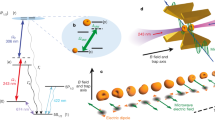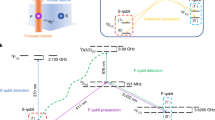Abstract
Conventional information processors convert information between different physical carriers for processing, storage and transmission. It seems plausible that quantum information will also be held by different physical carriers in applications such as tests of fundamental physics, quantum enhanced sensors and quantum information processing. Quantum controlled molecules, in particular, could transduce quantum information across a wide range of quantum bit (qubit) frequencies—from a few kilohertz for transitions within the same rotational manifold1, a few gigahertz for hyperfine transitions, a few terahertz for rotational transitions, to hundreds of terahertz for fundamental and overtone vibrational and electronic transitions—possibly all within the same molecule. Here we demonstrate entanglement between the rotational states of a 40CaH+ molecular ion and the internal states of a 40Ca+ atomic ion2. We extend methods used in quantum logic spectroscopy1,3 for pure-state initialization, laser manipulation and state readout of the molecular ion. The quantum coherence of the Coulomb coupled motion between the atomic and molecular ions enables subsequent entangling manipulations. The qubit addressed in the molecule has a frequency of either 13.4 kilohertz1 or 855 gigahertz3, highlighting the versatility of molecular qubits. Our work demonstrates how molecules can transduce quantum information between qubits with different frequencies to enable hybrid quantum systems. We anticipate that our method of quantum control and measurement of molecules will find applications in quantum information science, quantum sensors, fundamental and applied physics, and controlled quantum chemistry.
This is a preview of subscription content, access via your institution
Access options
Access Nature and 54 other Nature Portfolio journals
Get Nature+, our best-value online-access subscription
$29.99 / 30 days
cancel any time
Subscribe to this journal
Receive 51 print issues and online access
$199.00 per year
only $3.90 per issue
Buy this article
- Purchase on Springer Link
- Instant access to full article PDF
Prices may be subject to local taxes which are calculated during checkout



Similar content being viewed by others
Data availability
The data that support the findings of this work are available from the corresponding author upon reasonable request.
Code availability
The computer code used to analyse the data is available from the corresponding author upon reasonable request.
References
Chou, C.-w. et al. Preparation and coherent manipulation of pure quantum states of a single molecular ion. Nature 545, 203–207 (2017).
Bermudez, A. et al. Assessing the progress of trapped-ion processors towards fault-tolerant quantum computation. Phys. Rev. X 7, 041061 (2017).
Chou, C.-w. et al. Frequency-comb spectroscopy on pure quantum states of a single molecular ion. Science 367, 1458–1461 (2020).
Ballance, C. J., Harty, T. P., Linke, N. M., Sepiol, M. A. & Lucas, D. M. High-fidelity quantum logic gates using trapped-ion hyperfine qubits. Phys. Rev. Lett. 117, 060504 (2016).
Gaebler, J. P. et al. High-fidelity universal gate set for 9Be+ ion qubits. Phys. Rev. Lett. 117, 060505 (2016).
Levine, H. et al. High-fidelity control and entanglement of Rydberg-atom qubits. Phys. Rev. Lett. 121, 123603 (2018).
Bernien, H. et al. Probing many-body dynamics on a 51-atom quantum simulator. Nature 551, 579–584 (2017).
Zhang, J. et al. Observation of a many-body dynamical phase transition with a 53-qubit quantum simulator. Nature 551, 601–604 (2017).
McConnell, R., Zhang, H., Hu, J., Ćuk, S. & Vuletić, V. Entanglement with negative Wigner function of almost 3,000 atoms heralded by one photon. Nature 519, 439–442 (2015).
Bohnet, J. G. et al. Quantum spin dynamics and entanglement generation with hundreds of trapped ions. Science 352, 1297–1301 (2016).
Luo, X.-Y. et al. Deterministic entanglement generation from driving through quantum phase transitions. Science 355, 620–623 (2017).
Omran, A. et al. Generation and manipulation of Schrödinger cat states in Rydberg atom arrays. Science 365, 570–574 (2019).
DeMille, D. Quantum computation with trapped polar molecules. Phys. Rev. Lett. 88, 067901 (2002).
Kozyryev, I. & Hutzler, N. R. Precision measurement of time-reversal symmetry violation with laser-cooled polyatomic molecules. Phys. Rev. Lett. 119, 133002 (2017).
Cairncross, W. B. et al. Precision measurement of the electron’s electric dipole moment using trapped molecular ions. Phys. Rev. Lett. 119, 153001 (2017).
Altuntaş, E., Ammon, J., Cahn, S. B. & DeMille, D. Demonstration of a sensitive method to measure nuclear-spin-dependent parity violation. Phys. Rev. Lett. 120, 142501 (2018).
ACME Collaboration. Improved limit on the electric dipole moment of the electron. Nature 562, 355–360 (2018).
Safronova, M. S. et al. Search for new physics with atoms and molecules. Rev. Mod. Phys. 90, 025008 (2018).
Moses, S. A., Covey, J. P., Miecnikowski, M. T., Jin, D. S. & Ye, J. New frontiers for quantum gases of polar molecules. Nat. Phys. 13, 13–20 (2017).
Liu, L. R. et al. Building one molecule from a reservoir of two atoms. Science 360, 900–903 (2018).
Truppe, S. et al. Molecules cooled below the Doppler limit. Nat. Phys. 13, 1173–1176 (2017).
Ospelkaus, S. et al. Controlling the hyperfine state of rovibronic ground-state polar molecules. Phys. Rev. Lett. 104, 030402 (2010).
Reinaudi, G., Osborn, C. B., McDonald, M., Kotochigova, S. & Zelevinsky, T. Optical production of stable ultracold 88Sr2 molecules. Phys. Rev. Lett. 109, 115303 (2012).
Park, J. W., Will, S. A. & Zwierlein, M. W. Ultracold dipolar gas of fermionic 23Na40K molecules in their absolute ground state. Phys. Rev. Lett. 114, 205302 (2015).
Yan, B. et al. Observation of dipolar spin-exchange interactions with lattice-confined polar molecules. Nature 501, 521–525 (2013).
Hu, M.-G. et al. Direct observation of bimolecular reactions of ultracold KRb molecules. Science 366, 1111–1115 (2019).
Cheuk, L. W. et al. Observation of collisions between two ultracold ground-state CaF molecules. Preprint at http://arxiv.org/abs/2002.00048 (2020).
Yang, H. et al. Observation of magnetically tunable Feshbach resonances in ultracold 23Na40K + 40K collisions. Science 363, 261–264 (2019).
Biesheuvel, J. et al. Probing QED and fundamental constants through laser spectroscopy of vibrational transitions in HD+. Nat. Commun. 7, 10385 (2016).
Alighanbari, S., Hansen, M. G., Korobov, V. I. & Schiller, S. Rotational spectroscopy of cold and trapped molecular ions in the Lamb–Dicke regime. Nat. Phys. 14, 555–559 (2018).
Schmidt, P. O. et al. Spectroscopy using quantum logic. Science 309, 749–752 (2005).
Wolf, F. et al. Non-destructive state detection for quantum logic spectroscopy of molecular ions. Nature 530, 457–460 (2016).
Sinhal, M., Meir, Z., Najafian, K., Hegi, G. & Willitsch, S. Quantum non-demolition state detection and spectroscopy of single trapped molecules. Science 367, 1213–1218 (2020).
Hudson, E. R. & Campbell, W. C. Dipolar quantum logic for freely rotating trapped molecular ions. Phys. Rev. A 98, 040302 (2018).
Ni, K.-K., Rosenband, T. & Grimes, D. D. Dipolar exchange quantum logic gate with polar molecules. Chem. Sci. 9, 6830–6838 (2018).
Kippenberg, T. J. & Vahala, K. J. Cavity optomechanics: back-action at the mesoscale. Science 321, 1172–1176 (2008).
Schuster, D. I., Bishop, L. S., Chuang, I. L., DeMille, D. & Schoelkopf, R. J. Cavity QED in a molecular ion trap. Phys. Rev. A 83, 012311 (2011).
Campbell, W. C. & Hudson, E. R. Dipole-phonon quantum logic with trapped polar molecular ions. Preprint at http://arxiv.org/abs/1909.02668 (2019).
Leibfried, D. et al. Creation of a six-atom ‘Schrödinger cat’ state. Nature 438, 639–642 (2005).
Rugango, R. et al. Sympathetic cooling of molecular ion motion to the ground state. New J. Phys. 17, 035009 (2015).
Sackett, C. A. et al. Experimental entanglement of four particles. Nature 404, 256–259 (2000).
Ding, S. & Matsukevich, D. N. Quantum logic for the control and manipulation of molecular ions using a frequency comb. New J. Phys. 14, 023028 (2012).
Leibfried, D. Quantum state preparation and control of single molecular ions. New J. Phys. 14, 023029 (2012).
Roos, C. F. et al. Nonlinear coupling of continuous variables at the single quantum level. Phys. Rev. A 77, 040302 (2008).
Nie, X. R., Roos, C. F. & James, D. F. V. Theory of cross phase modulation for the vibrational modes of trapped ions. Phys. Lett. A 373, 422–425 (2009).
Bartels, A., Oates, C. W., Hollberg, L. & Diddams, S. A. Stabilization of femtosecond laser frequency combs with subhertz residual linewidths. Opt. Lett. 29, 1081–1083 (2004).
Merkel, B. et al. Magnetic field stabilization system for atomic physics experiments. Rev. Sci. Instrum. 90, 044702 (2019).
Langer, C. et al. Long-lived qubit memory using atomic ions. Phys. Rev. Lett. 95, 060502 (2005).
Roos, C. F. et al. Experimental demonstration of ground state laser cooling with electromagnetically induced transparency. Phys. Rev. Lett. 85, 5547–5550 (2000).
Roos, Ch. et al. Quantum state engineering on an optical transition and decoherence in a Paul trap. Phys. Rev. Lett. 83, 4713–4716 (1999).
Acknowledgements
We thank J. Du, J. J. Bollinger and A. L. Collopy for reading and providing feedback on this manuscript, and C. Kurz for help on the experimental setup. This work was supported by the US Army Research Office (grant number W911NF-19-1-0172). Y.L. acknowledges support from the National Key R&D Program of China (grant number 2018YFA0306600), the National Natural Science Foundation of China (grant number 11974330) and Anhui Initiative in Quantum Information Technologies (grant number AHY050000).
Author information
Authors and Affiliations
Contributions
Y.L., C.-w.C., D.R.L. and D.L. conceived and designed the experiments and contributed to the development of experimental methods and pulse sequences. C.-w.C., D.R.L. and D.L. developed components of the experimental apparatus. Y.L. collected and analysed the data. Y.L., C.-w.C. and D.L. wrote the manuscript. All authors provided suggestions for the experiments, discussed the results and contributed to the editing of the manuscript.
Corresponding author
Ethics declarations
Competing interests
The authors declare no competing interests.
Additional information
Peer review information Nature thanks Lawrence Cheuk, Barak Dayan and the other, anonymous, reviewer(s) for their contribution to the peer review of this work.
Publisher’s note Springer Nature remains neutral with regard to jurisdictional claims in published maps and institutional affiliations.
Rights and permissions
About this article
Cite this article
Lin, Y., Leibrandt, D.R., Leibfried, D. et al. Quantum entanglement between an atom and a molecule. Nature 581, 273–277 (2020). https://doi.org/10.1038/s41586-020-2257-1
Received:
Accepted:
Published:
Issue Date:
DOI: https://doi.org/10.1038/s41586-020-2257-1
This article is cited by
-
Quantum logic detection of collisions between single atom–ion pairs
Nature Physics (2022)
-
Optimization two-qubit quantum gate by two optical control methods in molecular pendular states
Scientific Reports (2022)
-
Resonant and non-resonant optimizations by multi-constraint quantum control theory in molecular rotational states
Scientific Reports (2022)
-
Identification of molecular quantum states using phase-sensitive forces
Nature Communications (2020)
Comments
By submitting a comment you agree to abide by our Terms and Community Guidelines. If you find something abusive or that does not comply with our terms or guidelines please flag it as inappropriate.



